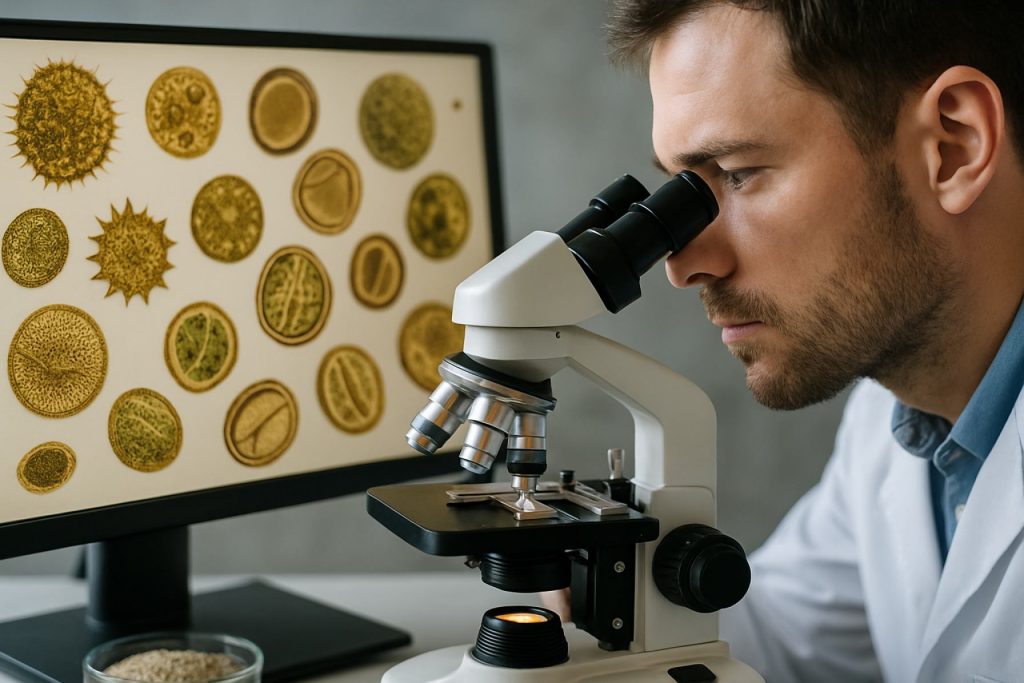
Discover the Science of Palynology: How Microscopic Pollen Grains Reveal the Hidden History of Our Planet. Explore the Techniques, Applications, and Surprising Insights of This Fascinating Field.
- Introduction to Palynology: Definition and Historical Development
- The Science Behind Pollen and Spores: Morphology and Identification
- Techniques and Tools in Palynological Research
- Applications in Geology and Paleoclimatology
- Palynology in Archaeology and Forensic Science
- Environmental and Ecological Insights from Palynological Studies
- Challenges and Future Directions in Palynology
- Sources & References
Introduction to Palynology: Definition and Historical Development
Palynology is the scientific study of microscopic, acid-resistant organic particles such as pollen, spores, and certain plankton. These microfossils are invaluable for reconstructing past environments, understanding plant evolution, and aiding in disciplines such as geology, archaeology, and forensic science. The term “palynology” was first coined in 1944, but the roots of the discipline trace back to the 17th century, when early microscopists like Robert Hooke and Marcello Malpighi observed pollen grains under primitive microscopes. Systematic study began in the 19th century, with botanists recognizing the taxonomic value of pollen morphology. The 20th century saw palynology emerge as a distinct field, particularly after the development of chemical techniques to extract pollen from sediments and the formalization of nomenclature and classification systems.
Palynology’s historical development is closely linked to advances in microscopy and sediment analysis. In the early 1900s, Swedish geologist Lennart von Post pioneered the use of pollen analysis for reconstructing post-glacial vegetation history, laying the foundation for modern paleoecology. The discipline expanded rapidly after World War II, with applications in petroleum exploration, Quaternary geology, and climate science. Today, palynology is a multidisciplinary science, integrating methods from biology, geology, and chemistry to address questions about Earth’s history and human-environment interactions. For a comprehensive overview of the field’s history and significance, see resources from the International Federation of Palynological Societies and the Geological Society of London.
The Science Behind Pollen and Spores: Morphology and Identification
The science of palynology relies heavily on the detailed study of pollen and spore morphology for accurate identification and classification. Pollen grains and spores are microscopic, typically ranging from 10 to 200 micrometers, and their outer walls—known as exines—exhibit intricate patterns and structures unique to each plant species. These morphological features include size, shape, aperture type (such as pores or furrows), and surface ornamentation (like spines, reticulations, or granules). Advanced microscopy techniques, including light microscopy and scanning electron microscopy, are essential tools for visualizing these minute details, allowing palynologists to distinguish between closely related taxa Natural History Museum.
Identification begins with the preparation of samples, often involving chemical treatments to remove organic material and isolate the resilient exine. Once prepared, pollen and spores are compared against reference collections and identification keys, which catalog the diagnostic features of thousands of species. The process is meticulous, as even minor variations in morphology can indicate different genera or families. This precision is crucial in fields such as paleobotany, where fossilized pollen and spores provide insights into ancient vegetation and climate, and in forensic science, where pollen evidence can link suspects to crime scenes Encyclopædia Britannica.
Recent advances in digital imaging and machine learning are further enhancing the accuracy and speed of pollen and spore identification, opening new possibilities for large-scale ecological and environmental studies Royal Botanic Gardens, Kew.
Techniques and Tools in Palynological Research
Palynological research relies on a suite of specialized techniques and tools to analyze pollen, spores, and other microscopic organic particles. The process typically begins with sample collection from sediments, soils, or archaeological materials, followed by chemical preparation to isolate palynomorphs. Standard preparation involves treatments with acids (such as hydrochloric and hydrofluoric acid) to remove carbonates and silicates, leaving behind the resistant organic material. The resulting residues are then mounted on microscope slides for examination.
Light microscopy remains the cornerstone of palynological analysis, allowing researchers to identify and count pollen grains based on their morphological features. Advances in imaging, such as scanning electron microscopy (SEM), provide higher-resolution images, enabling detailed surface structure analysis and more precise taxonomic identification. Digital image analysis and automated pollen recognition systems are increasingly being integrated to enhance throughput and reduce observer bias.
Quantitative techniques, such as pollen concentration and influx calculations, are used to reconstruct past vegetation and environmental conditions. Radiocarbon dating and other chronological tools are often employed alongside palynological data to establish temporal frameworks for paleoenvironmental reconstructions. Additionally, molecular techniques, including DNA metabarcoding, are emerging as powerful tools for identifying plant taxa from pollen samples, complementing traditional morphological approaches.
The integration of these diverse methods has significantly expanded the scope and accuracy of palynological research, supporting applications in fields ranging from paleoclimatology to forensic science. For further details on laboratory protocols and instrumentation, see resources provided by the British Palynological Society and the American Association of Stratigraphic Palynologists.
Applications in Geology and Paleoclimatology
Palynology, the study of pollen, spores, and other microscopic plant remains, plays a crucial role in geology and paleoclimatology by providing insights into past environments and climate changes. In geological contexts, palynological analysis is widely used for biostratigraphy, helping to date and correlate sedimentary rock layers based on the presence and succession of specific pollen and spore assemblages. This is particularly valuable in petroleum exploration, where identifying the age and depositional environment of rock strata can guide drilling decisions and resource assessments (U.S. Geological Survey).
In paleoclimatology, palynology offers a window into historical vegetation patterns and, by extension, past climate conditions. Pollen grains preserved in lake sediments, peat bogs, and other depositional environments serve as proxies for reconstructing changes in temperature, precipitation, and ecosystem dynamics over thousands to millions of years. By analyzing shifts in pollen assemblages, researchers can infer periods of glaciation, aridification, or warming, contributing to our understanding of natural climate variability and aiding in the calibration of climate models (National Centers for Environmental Information).
Additionally, palynological data are instrumental in reconstructing paleoenvironments associated with archaeological sites, helping to contextualize human evolution and migration. The integration of palynology with other geological and geochemical proxies enhances the resolution and reliability of paleoenvironmental reconstructions, making it an indispensable tool in Earth sciences (British Geological Survey).
Palynology in Archaeology and Forensic Science
Palynology, the study of pollen and spores, plays a significant role in both archaeology and forensic science by providing critical environmental and chronological information. In archaeology, palynological analysis of sediment samples from archaeological sites enables researchers to reconstruct past landscapes, climate conditions, and human activities. By identifying and quantifying pollen grains preserved in soil layers, archaeologists can infer the types of vegetation present during different periods, track agricultural practices, and detect anthropogenic changes in the environment. For example, shifts in pollen assemblages may indicate the introduction of crop cultivation or deforestation events associated with ancient settlements (British Museum).
In forensic science, palynology serves as a powerful tool for linking suspects, objects, or locations to specific crime scenes. Pollen grains are highly resilient and can adhere to clothing, hair, or personal belongings, often persisting even after attempts to clean or remove them. Forensic palynologists analyze these microscopic traces to determine the geographical origin of evidence or to establish timelines and movement patterns. The unique combination of pollen types in a given area acts as a biological fingerprint, which can corroborate or challenge alibis and testimonies in criminal investigations (Federal Bureau of Investigation). The application of palynology in both fields underscores its value in reconstructing past environments and solving modern legal cases, highlighting the interdisciplinary nature of this scientific discipline.
Environmental and Ecological Insights from Palynological Studies
Palynological studies provide critical insights into past and present environmental and ecological conditions by analyzing pollen and spores preserved in sediments, soils, and other substrates. Through the identification and quantification of these microfossils, researchers can reconstruct historical vegetation patterns, track climate fluctuations, and infer anthropogenic impacts on ecosystems. For example, shifts in pollen assemblages within sediment cores often reflect changes in regional flora due to climatic events such as glaciations, droughts, or warming periods. These reconstructions are essential for understanding long-term ecological dynamics and for predicting future environmental changes in response to ongoing climate change (Nature Ecology & Evolution).
Palynology also plays a vital role in detecting human-induced landscape modifications, such as deforestation, agriculture, and urbanization. The presence of cultivated plant pollen or increased charcoal particles in sediment layers can indicate the onset of farming or fire management practices by ancient societies. Such data help archaeologists and ecologists trace the development of human-environment interactions over millennia (Cambridge University Press).
Furthermore, modern palynological monitoring assists in tracking airborne pollen, which is crucial for allergy forecasting and understanding plant reproductive ecology. By integrating palynological data with other proxies, such as isotopic or macrofossil evidence, scientists can achieve a more comprehensive view of ecosystem responses to both natural and anthropogenic drivers (Quaternary Science Reviews).
Challenges and Future Directions in Palynology
Palynology, the study of pollen and spores, faces several challenges as it advances into the 21st century. One significant issue is the accurate identification of pollen grains, which often requires expert knowledge and can be time-consuming due to the morphological similarity among taxa. The development of automated identification systems using machine learning and image analysis is a promising direction, but these technologies still require extensive, high-quality reference databases and validation across diverse floras Nature Publishing Group.
Another challenge is the preservation and recovery of pollen from sedimentary records, which can be affected by taphonomic processes, chemical degradation, and sampling biases. These factors may skew reconstructions of past vegetation and climate. Advances in chemical extraction techniques and non-destructive imaging methods are being explored to mitigate these issues Elsevier.
The integration of molecular techniques, such as environmental DNA (eDNA) analysis, offers new opportunities for palynology. These methods can complement traditional microscopy by providing taxonomic resolution at the species level, but challenges remain in standardizing protocols and interpreting mixed DNA signals from complex samples Frontiers Media S.A..
Looking forward, the future of palynology lies in interdisciplinary collaboration, the adoption of big data analytics, and the continued refinement of both classical and molecular approaches. These advances will enhance the field’s ability to address questions in paleoecology, climate change, and biodiversity conservation.
Sources & References
- International Federation of Palynological Societies
- Geological Society of London
- Natural History Museum
- Royal Botanic Gardens, Kew
- National Centers for Environmental Information
- British Geological Survey
- Nature Ecology & Evolution
- Frontiers Media S.A.



